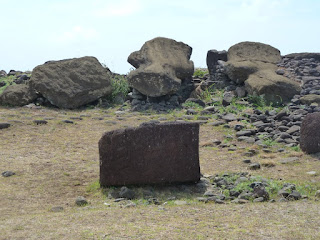

Garry and I are back in Santiago this evening after an inspiring two and a half days on Easter Island (known to the Chileans as Isle de Pascua). The weather was warm and sunny much of the time making our daily excursions all the more enjoyable. I'll post more details shortly, but here are a couple of photos from our time on the island. Tomorrow morning we fly north to Calama to join a four-day tour of the Atacama Desert.
UPDATE
I've now expanded this post to include more about our time on Easter Island. Scroll down and enjoy!

I've now expanded this post to include more about our time on Easter Island. Scroll down and enjoy!


Where do I begin? Our unexpected stranding in Antarctica threw a spanner in the works for the next leg of our Chilean tour. We'd originally booked three nights in Santiago, followed by three nights on Easter Island. As I've shared in earlier posts, I managed to salvage our itinerary by rescheduling flights to Easter Island two days later than planned and rebooking a room in the same hotel.
Our luck continued when we landed on Easter Island. We ran into the local guide we’d originally booked for tours around the island. She was collecting another couple from our flight. Upon hearing of our polar plight, she renewed our original tour itinerary at no additional cost. Even better, she gave us a ride to our hotel and confirmed a pickup for the following day.
This left us out of pocket for just the rebooked hotel room. However, shortly after returning to Sydney, the UK travel agent who’d processed our room booking made contact. She’d heard we never checked in. I duly shared our stranding and rebooking experience. To my surprise, the agent contacted the hotel and secured a refund for our duplicate booking.
How remarkable is that? We’d arrived on Easter Island on 2 January, convinced we'd blown our money on a series of "no-shows". In the end, the entire sector was rescheduled at no additional cost. Although, despite the eleventh-hour reprieve, we came perilously close to losing it all a second time.
Our rescheduled flight to Easter Island departed early morning. Hence, we sensibly booked ourselves into the Airport Holiday Inn directly opposite the airport terminal. However, after an exhausting day flying from the South Shetland Islands and onwards to Santiago, I forgot to set my alarm. We woke the following morning, 40 minutes before our flight closed.
A quick flurry of activity saw us present ourselves at the LAN Chile counter with minutes to spare. The check-in hall was all but empty, with barely a person in sight. The staff behind the desk looked at us long and hard, examined our tickets, and then huddled among themselves before eventually checking us in.
Our first afternoon on Easter Island was spent exploring the township of Ranga Hoa. This is the only permanently inhabited settlement on Rapa Nui (the islander's native name for Easter Island). We walked as far as a small cove that provides the island's only sheltered port. It was here we caught a glimpse of our first moai statue, Ahu Hotake, standing guard over the harbour's entrance.
Orongo sits on the southernmost cliff tops of Easter Island
overlooking the flooded volcanic crater of Rano Kau. Here, in the 18th and 19th
centuries, the island's unique birdman culture flourished. Youths would compete in a
ritual each spring to secure the season's first Sooty Tern egg. These birds nest annually on a small pinnacle of rock several hundred metres offshore.
Securing the egg required scrambling down a near-vertical cliff, swimming through heavy ocean swells, climbing the jagged pinnacle, and finally returning to the top of the cliff. Whichever returned first with their egg intact was crowned ceremonial chief for another year.
The night before the big event, these young men spent the night resting in a series of low-profile stone huts built along the cliff top. In reality, these huts are little more than open-faced rock shelters with a compressed mud floor and an internal ceiling no higher than a dog kennel. Our guide let us crawl in and carefully explore one of the preserved hut’s cramped confines.
A most remarkable view lies just beyond the stone huts. In one direction, the ground slopes towards spectacular sea cliffs. In the opposite direction, the broad volcanic rim of Rano Kau towers over a permanent crater lake. The crater is almost two kilometres wide and unlike much of the island, it's a green oasis of plant life. I've visited this location on two separate occasions. However, I still marvel at the weed-covered waters sitting on the crater floor more than a hundred metres below.
The next stop on our tour was Ahu Vinapu. This extraordinary stone platform sits on a slope beyond the eastern threshold of the airport runway. The craftsmanship displayed in the assembly of its stonework is unique on the island. The precision and style are almost identical to those seen in the likes of Cusco, more than 3000km to the east. Researchers are divided as to whether this platform proves that the islanders were influenced by Incan culture.
Our next stop was Ahu Akahanga. This is one of the island's largest unrestored ceremonial platforms. The platform is 18 meters in length and once supported a total of 13 moai varying between five and seven metres in height. All these statues have long since been toppled.
However, in most destroyed platforms, the statues lie face down with their iconic features hidden from view. The opposite is true at Ahu Akahanga. Its moai were knocked down, lying both face-up and face-down. It's awe-inspiring to see these stone giants in such a vulnerable position when once they stood proudly on a pedestal.
Follow this link for more about our tour of Easter Island, including a visit to the island's two most iconic locations, Rano Raraku, and Ahu Tongariki.























No comments:
Post a Comment